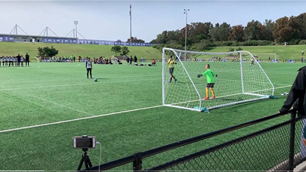What’s a pass mark for the A-League this season?
It’s fair to say expectations and excitement around the A-League haven’t been this high since the league’s debut season in 2005, when everything was new, bright and shiny.
This justified optimism comes at such an opportune time for the league; with crowds hitting an all-time low last season, as pessimism spread following the failed World Cup bid and the demise of the North Queensland Fury.
Yet with the injection of Harry Kewell, Brett Emerton, Football Federation Australia going on the front foot in promoting the league and generating some buzz, a later and more favourable start date, and strong signings and squads across the big five markets – Melbourne, Sydney, Brisbane, Adelaide and Perth – there’s cause for optimism.
But how much optimism?
As we saw last season, there was nothing wrong with the football on show; Brisbane Roar setting a new standard, comparable with much older and established leagues. It’s just that progress didn’t translate into bums on seats and thus bottom lines.
So, what needs to be achieved crowd-wise for the league to be able to look back on this season as the turning point?
The league must improve on the 8393 crowd average of last season – almost goes without saying. That is, the competition must see the first increase in crowd averages since 2007-2008, when the average peaked at 14,608 before its slide to four figures in the last two seasons.
This is when we start predicting what impact Kewell-mania will have.
You’d expect Melbourne Victory to improve on last season’s average of 15,234, perhaps making up the 6000-odd attendees they lost from 2009-10 and getting back to or exceeding the 27,728 they had in season two.
Kewell could do what the arrival of Melbourne Heart couldn’t; genuinely expand the game’s fan base in the Victorian capital, as Melbourne Heart’s arrival into the market last season undoubtedly chipped away at the Victory’s average, as some switched their allegiances. It’s no coincidence the drop in Victory’s crowd average was around the same mark as Heart’s average of 8312.
Heart’s average could be telling for the league. Having invested so heavily in community engagement programs, actively going out into the far reaches of Victoria to spread the word, they need to improve on last season’s mark – and they should do, as their identity and brand grows, differentiating itself more and more from the Victory. But they face a titan across town in the Kewell-Victory combo.
Without Kewell there to inflate crowds, Heart’s numbers could prove a better test of the success of delaying the season – particularly in a market like Melbourne, avoiding the AFL season – the FFA’s marketing push and serious community engagement.
Elsewhere, Sydney FC must get its average back up to five figures (last season’s average of 7656 the worst in the club’s history; losing around 5000 on the previous campaign). While Emerton may not command the same sexy headlines as Kewell, his presence should help the club in such a challenging market – particularly if he helps them get back to winning ways.
Brisbane Roar should push five figures and improve on last season’s 9279 mark, although membership numbers haven’t set tongues wagging – certainly not when you consider how well the club played last season and the drama of their championship win.
Adelaide United is a model of consistency when it comes to crowds (second only to Melbourne Victory), so with what looks like a strong team, they should continue to impress off the park this season.
It may be a stretch for Central Coast to get into five figures, considering they were at 7713 last season, but there should be some improvement given last season’s form and a continuation of winning ways… you’d hope!
Newcastle Jets may be in turmoil following the sacking of Branko Culina, but their aggressive membership drive has netted close to 10,000 members. If they turn up and back the club through what could be a very lean spell on the field, then they at the very least should match if not exceed last season’s 8429 average.
Perth Glory needs to start turning their impressive activity in the transfer market into some consistent winning, and until they do so, they won’t improve on the 8488 average of last season (their crowd average has consistently sat around that mark in the A-League).
Then we get to the two real concerns. Wellington Phoenix’s ownership change, the uncertainty that brings, inactivity in the transfer market, and expected on-field struggle leaves them in a spot of bother. Don’t expect them to improve on their average of 7981.
Finally we get to Gold Coast United – that basketcase when it comes to crowds. Their average went from 5392 in their first season to 3434 last – embarrassing for the club and the league.
In response to this and facing a greater fall following the loss of star names such as Smeltz, Culina, Djite and co, the club has dramatically reduced ticket prices. An adult general admission ticket to Skilled Park's eastern stand will cost you $20 compared to $37 last season, while kids under 14 can get in for $5 compared to $22 last season.
Can it work? It’s the desperate act of a desperate club, knowing it faced oblivion if it didn’t act aggressively. It could, on the one hand, compensate for the absence of genuine marquee players and keep crowds at last season’s mark. Much could depend on what the young side can produce. But if the slide continues, then the FFA needs to seriously scrutinise whether the club has a future. Either way, it will be fascinating to watch and will be an interesting test on the impact of ticket prices.
Therefore, there could be some very lopsided crowd averages across the league – boom time in the big markets but struggles in the smaller ones.
At a minimum the league needs to get back to having a five-figure average across the whole league. If Kewell-mania exceeds, then an average of or over 15,000 should be possible. Less midweek matches will also help.
But the club’s struggling at the bottom really weigh down the average, together with the unknown of the regional rounds, then it could limit growth.
Whatever the result, if there is an increase, the key will be distinguishing the Kewell-effect from the other likely causes of that increase – ‘clean air’ October start, cheaper tickets and/or the marketing push. The FFA needs to learn what works in pulling crowds.
With those positive additions and changes, there needs to be some genuine improvements off the park in the A-League this season. No excuses.
Related Articles

Fresh talent flock to ambitious A-League outfit's pro pathway

Why A-League 20/21 is crucial for Olyroos’ medal hopes













